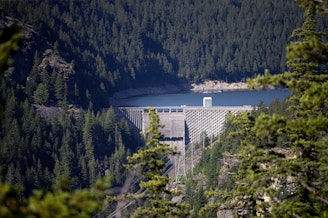A different kind of winter fun: tidepooling at night on Puget Sound

On a drizzly Saturday night in February, dozens of people walked with headlamps and flashlights at water’s edge near the Edmonds, Washington, fishing pier, on the eastern shore of Puget Sound. They weren’t there to catch fish or squid: They came to see the wonders that come out when the tide goes out.
Some activities can only be done in certain seasons, but tidepooling is enjoyable year-round – if you don’t mind the cold and the dark.
In winter, the Pacific Northwest’s lowest tides come at night.

Eight-year-old pals Evelyn McGann and Vanessa Joyce clambered over the glistening boulders that protect the fishing pier, with their parents nearby.
Sponsored
In between the boulders were brightly colored blobs, each about the size of a droopy softball.
“A Christmas anemone,” Evelyn correctly identified one of the striped blobs. “You can see a pink one and a dark pink one over here.”
“But when you touch one of these poky things, it closes his arms,” Vanessa observed of the anemones’ stubby tentacles.
All around, people seemed to be staring at their feet.

Beach naturalist Jonathan Robinson with Washington State University Snohomish County Extension helped people understand what they were seeing.
“These right here are all barnacle-eating nudibranchs,” Robinson said, pointing his light at a group of knobby, pea-sized blobs that somehow make a living eating the biological fortresses known as barnacles. “They love the pilings under the ferry terminal. The pilings are just covered with barnacles. So, it's like a giant buffet for them.”
Robinson said, in some ways, night tidepooling is better than day tidepooling.
“At night, you can see some animals that you don't see in the daytime. A lot of the crabs feel more comfortable coming out and crawling around, whereas if it came out in the daytime, they'll get picked off by a bird and eaten,” Robinson told a group of head-lamped visitors.

Robinson said you never know what you’ll find on a low tide.
“Every single time I come down here, I see something different. I see something amazing, unique. Being able to show people something that they haven't seen before is probably one of my favorite things out here,” Robinson said. “Fostering that sense of wonder.”

University of Washington graduate student and former clam researcher Marisa Yonemitsu did the night beach walk with her mother.
“I'm a big sea slug fan, so I kind of look for those every time I go,” she said.
Sponsored
Slugs on land are usually seen as slimy garden pests. Sea slugs are more like otherworldly hallucinations of wildly varying forms and colors.
“They’re also just very cute,” Yonemitsu said.
She found a sea slug called a shaggy mouse nudibranch.
“If you've seen like a hedgehog before, it kind of looks like that," she said. "It's very sort of fluffy looking.”
While Yonemitsu is a frequent tidepooler, many people were exploring an intertidal zone for the first time.
Sponsored
“I had no idea,” Manny Dunham of Edmonds said. “I mean, I knew creatures were out here, doing whatever, but didn't know exactly the full extent.”
“We saw a starfish, two crabs and baby eels and two pods of eggs,” Dunham’s 8-year-old daughter Melaina said.
When a reporter asked if it was surprising to see those creatures, Dunham chose her words carefully.
“It was... it was magical,” she said. “Great to see them.”
“Little Mermaid talk, I love it,” her father said.
Sponsored

A network of researchers has been tracking sea star populations up and down the West Coast since a wasting disease devastated the charismatic invertebrates starting a decade ago.
RELATED: Signs of recovery after world’s worst underwater pandemic
In Edmonds, as in many places, sea star numbers still haven’t recovered. In 2024, researchers found 15 ochre stars and 8 mottled stars in Edmonds, down from about 100 each a decade earlier, but no sign of any wasting disease in either species.

The Seattle Aquarium laid off its beach naturalist staff in February, with the future of its volunteer-led activities around King County in doubt. Robinson said he’s planning tidepool events in Snohomish County for the daytime low tides of spring and summer, starting in mid-May.
All good things must come to an end, and after about an hour of exploration by kids and adults, the tide crept back in.
Sponsored
The creatures that shared the spotlight for a moment got to chill out in the dark and wet again until the next really low tide.





